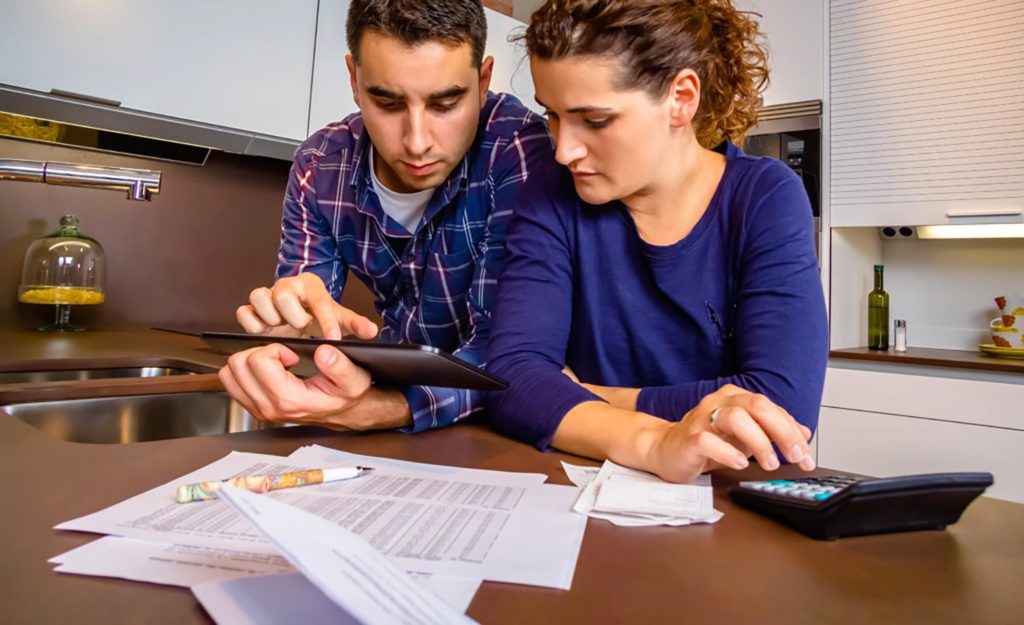The state of household debt in America is a troubling one. Household debt hasn’t been as high as it is now since the beginning of the financial meltdown and, unfortunately, it continues to climb. Household debt is now expected to be in excess of $13 trillion by the end of 2018, according to the most recent quarterly report of the New York Federal Reserve. This is on the heels of 2017, which showed the largest increase in household debt in a decade.
Part of the reason debt is soaring is because we’re now 10 years past the beginning of the Great Recession. Those that suffered mightily during that dark financial time have had the opportunity to recover. Bankruptcies and foreclosures have begun to drop off credit reports, and banks and other lenders have begun to loosen their lending standards again. With interest rates still comparatively low, money has become readily available and cheap to borrow.
With the economy on fire and consumer confidence flying high, Americans are feeling good about spending money and borrowing to make big-ticket purchases such as homes, cars, and major household goods. Wages are also growing and, for the first time in nearly a decade, income seems to be keeping up with the rising cost of living. This has fueled a rapid rise in the number of mortgage originations. In fact, the amount of new mortgages being written is the highest it’s been in a decade.
Mortgage debt makes up the largest amount of household debt, and it’s largely stable with a low number of delinquencies. Compared to the period just before the Great Recession, the number is very low. However, Americans have plenty of other debt such as credit card debt, student loans, and car loans. Should the economy continue to heat up quickly, the Federal Reserve could increase the pace of interest rate hikes, putting many Americans in a cash flow crunch.
How Do Americans Accumulate So Much Debt?
Unfortunately, many Americans simply don’t have enough income to meet their everyday expenses. In addition, with Americans being notoriously poor savers, there’s often too little money available to meet unexpected emergency expenditures. Because of this, many consumers are reliant upon credit cards to make ends meet and take care of things such as replacing appliances or paying for a car repair. There is a large swath of Americans that simply live paycheck to paycheck with very little opportunity to save money and get ahead.
Another problem is that most consumers have little knowledge of how to budget or manage their finances. Therefore, their spending is uncontrolled, leaving them in a situation of outspending their paychecks. When this trend continues month after month, credit card balances accumulate. This can lead to a substantial debt load in a relatively short period. Eventually, this financial death spiral results in the consumer running out of credit, being unable to meet financial obligations with few options to resolve the debt problem.
If consumers who are heavily in debt are proactive when they realize the trouble they’re in, there are options for getting out from under an oppressive debt situation. Consumers must recognize that in order to turn their situation around, the first thing they need to do is stop the deficit spending. Only then can they put together an effective plan for eliminating their debt and getting back on the road to financial health. This plan needs to include a way to reduce expenses, increase income, or both. It also needs to include an organized plan to pay off the debt and keep it from creeping back up again.
Ways to Reduce Debt
There are several angles of attack you can take to solve your debt problems. All of them will require a bit of sacrifice and a lot of persistence and dedication. Let’s explore a few.
Build a Budget
Most Americans don’t utilize a budget monthly or even know how to put one together. The average American pays his or her bills and hopes that paychecks will make it to the end of the month. Generally, it’s a constant struggle that leaves consumers vulnerable to having to use credit cards to make up for a cash deficit.
Making up a budget isn’t a hard task. If you need some help, there are many online resources to get you started and help you learn the ins and outs of budget building. It’s really a simple concept that just requires a little digging into your finances and getting a good understanding of how you’re spending your money. Once you have all the information, putting together a budget is a relatively easy task. Organizing all your current obligations and comparing it to how much money you bring home will help you identify where you’re overspending and how you might be able to cut back. While certain expenses are fixed such as mortgages or car loans, many areas of spending will have opportunities to trim spending.
Don’t Pay Unnecessary Late Charges
Many consumers don’t pay close attention to when bills are due and consistently pay them late. While paying a bill a few days late probably won’t affect your credit rating, it’ll likely cause you to be charged late fees and may even affect your interest rate. Make an effort to pay your bills on time even if it means biting the bullet and doing everything possible to get ahead of the game. If you can get to a place where you’re ahead on your bills, a little financial hiccup won’t derail you.
Some lenders will even allow you to move your due date to a date that’s friendlier to your paydays or budget. Obligations such as mortgages and car loans generally have very hefty late fees associated with them, so focus on those particularly, and pay them on time. Cutting out the late fees you pay every month could free up considerable cash that can be used to help you solve your debt problem.
In order to get ahead, consider drumming up some extra cash through holding a garage sale or selling items you no longer want or need through an online auction site such as eBay. Infusing a little extra cash into your situation can often be just the push you need to get going in the right direction.
Don’t Spend Your Money on Non-essentials
One of the reasons that budgets are so helpful is that they identify areas of wasteful spending. Sometimes, you may be bleeding cash on things you’re unaware of, such as old subscriptions or services you’re no longer using. These can come in the form of recurring automatic debits to your credit cards or bank accounts. These deductions from your accounts or charges to your credit cards can quietly drain much-needed cash flow, money that can be put to much better use.
Review all your monthly bills for ways to reduce them. Particularly pay attention to things such as your cable and phone bills where there are often add-ons that you’re not even aware of. While cutting out a few dollars here and there may not seem like much, it can add up and be an important part of helping to pay down your debt.
Other areas of opportunity to cut spending will be in your everyday expenditures. Making gourmet coffee at home rather than stopping on your way to work can save you big dollars over the course of a month. At $5 a day, you’re saving $100 a month!
Increase Your Income
Adding in some additional income through a second job or side business can help you close off any gaps you may have or, even better yet, help you start saving some money. Begin by funding an emergency account that you can turn to, rather than a credit card, to meet an unexpected expense. Once you have at least $1,000 saved, you can direct the extra cash toward paying down your debt.
Just make sure that you don’t absorb the extra money into everyday spending. Then, you’ll just be making your life harder without getting the benefit of reducing your debt. Have a plan for where every penny of the extra money will go.
Get Serious About Your Food and Entertainment Budget
One of the largest areas of your variable expenses each month will be on meals and entertainment. Therefore, it’ll also represent one of your biggest opportunities for saving money. Limit the amount of money you spend each day by packing your lunch and avoiding expensive lunches out. Even fast food at $10 a day adds up to $200 a month! By packing your lunches, you’ll not only have more money in your pocket, you’ll also be eating healthier meals.
When it comes to dinner, you can save lots of money by planning your meals and not overspending at the grocery store. By having a list and sticking to it, you can reduce the impulse buys and the purchasing of things you really don’t need. Having a plan will also keep you from ordering unhealthy and expensive take-out such as Chinese food and pizza.
Take advantage of the sales your grocery store has to offer when doing your meal planning. Often, you can find great buy one, get one deals on staples that you use all the time. Just be sure not to let the purchases of sale items cause you to overspend on your weekly budget. Overbuying can also lead to food expiring in your pantry, which is a complete waste of money.
Buy Used Items
You’ll always pay a premium when you buy things brand new. This is true for almost everything, including cars, clothes, appliances, and furniture. Check around your local area for consignment shops and thrift shops. Higher end consignment shops can provide you an opportunity to buy premium goods at pennies on the dollar. When it comes to buying cars, a year-old car can save you thousands of dollars. By letting someone else take the initial depreciation on the vehicle, you’ll likely never be upside down on your car note.
If you like nice clothes, try shopping at one of the higher end clothing consignment shops. These shops generally will only take in high-quality items in great condition. Many times, these items are unused and bear the original tags. Again, you’ll pay far less for items of good quality.
Thrift shops are a great place to find things such as tools, small appliances, and kitchenware. In addition, you can usually find great buys on plate ware, glasses, and decor. Whatever your needs are, chances are strong that you can find what you need for far less money by shopping around.
Conversely, if you have items in good condition that you’re no longer using, putting them on consignment can be an excellent source of extra cash that you can put toward eliminating your debt.
Make a Plan to Eliminate Your Debt
While all these things will help you get rid of a debt problem, it’s important to have a plan. Figure out the best way to pay off your balances in the shortest amount of time. Some people have had success with the snowball method, which starts by attacking the smallest balance first and then snowballing the payments until all the balances are paid. Other consumers have utilized the 3-year plan. This involves paying the amount needed to pay the card in full in 3 years. This information can be found on every credit card statement, as is required by law.
Whatever plan you choose, it’ll require some perseverance and dedication. But, if you’re diligent and smart, you’ll be on your way to a fresh start and a better financial future in no time.





